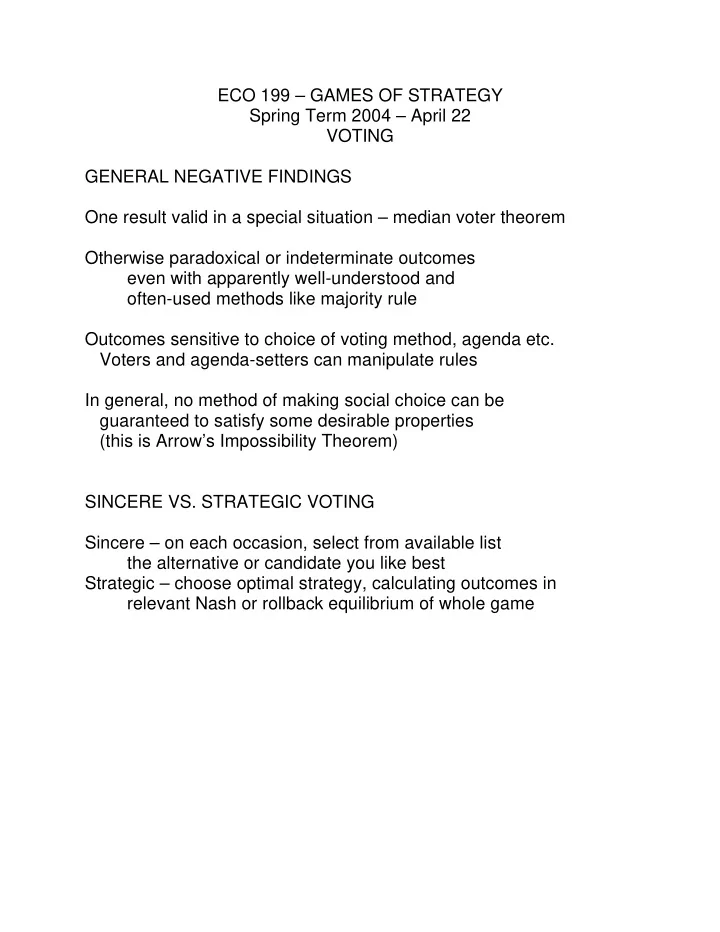

ECO 199 – GAMES OF STRATEGY Spring Term 2004 – April 22 VOTING GENERAL NEGATIVE FINDINGS One result valid in a special situation – median voter theorem Otherwise paradoxical or indeterminate outcomes even with apparently well-understood and often-used methods like majority rule Outcomes sensitive to choice of voting method, agenda etc. Voters and agenda-setters can manipulate rules In general, no method of making social choice can be guaranteed to satisfy some desirable properties (this is Arrow’s Impossibility Theorem) SINCERE VS. STRATEGIC VOTING Sincere – on each occasion, select from available list the alternative or candidate you like best Strategic – choose optimal strategy, calculating outcomes in relevant Nash or rollback equilibrium of whole game
MEDIAN VOTER THEORY One-dimensional issue spectrum Each individual has ideal point; “single-peaked” preferences fall away from it to either side In binary choice between any two issues, “Cut-point” splits voters Median voter’s ideal point beats everything else So power-motivated candidates/parties will choose to locate their policy platforms at that point
CONDORCET PARADOX Majority voting can be “intransitive” & create “cycles” If individual preferences are not “single-peaked” Cuban missile crisis example (book chapter 15, exercise 7) Original preferences in the ExComm (See The Kennedy Tapes, p. 97) Group Option Civ. Dove Civ. Hawk Military CD CH MIL Soft 1 3 2 Medium 2 1 3 Hard 3 2 1 (Soft = Blockade and negotiation Medium = Limited air strike on missile sites only Hard = Massive air strike leading to invasion) If each group has equal voting power, Soft beats Medium 2:1, Medium beats Hard 2:1, Hard beats Soft 2:1 So sequence of pairwise voting will produce cycle
TWO-ROUND PROCEDURE WITH SINCERE VOTING Agenda – Round 1 : Soft (S) v. Medium (M) Round 2 : Winner v. Hard (H) Sincere voting – Round 1 : S wins, 2 (CD, MIL) to 1 (CH) Round 2 : S v. H – H wins, 2 (MIL, CH) to 1 (CD) Should CD vote strategically for M in round 1? But then how would others vote strategically? STRATEGIC VOTING WITH SAME AGENDA Sincere voting in Round 2 – If Rd.2 is S vs. H, H wins; if Rd.2 is M vs. H, M wins Roll back to Round 1 – MIL votes: S M CH CH S M S M CD S H H CD S H M M H M M M M M is dominant for CD – strategic voting M is dominant for CH – no difference S is dominant for MIL – no difference Outcome M. CD’s strategic voting succeeds Similarly agenda-setter can get advantage by manipulating order in which issues are brought up pairwise
ECO 199 – GAMES OF STRATEGY Spring Term 2004 – April 22 BARGAINING NASH'S COOPERATIVE BARGAINING SOLUTION Two players A, B; total to be split = $1 If no agreement, they get a, b (BATNA) a + b < 1, so surplus available = 1 - a - b (Generalized) Nash Solution : A gets x, B gets y chosen on frontier x + y = 1 to maximize (x-a) h (y-b) k Result: x = a + h (1-a-b) , y = b + k (1-a-b) Relative bargaining strengths h + k = 1 Formal axiomatic derivation of Nash’s solution omitted here Variable threat bargaining: strategic moves change a, b A can gain by reducing a, so long as b is reduced by "more" Bargaining strengths h, k can be explained by considering sequence of offers, impatience (preference for early agreement) Then the more patient player (who discounts future at smaller rate of interest) gets bigger share of surplus (Formulas on pp. 584-5 of book)
MORE COMPLEX FEATURES OF REALITY 1. Asymmetric information - Signaling your own patience or good BATNA while screening for other's This is brinkmanship, can end in disagreement (strike, war) 2. Multi-issue bargaining Facilitates cross-issue deals by exploiting differences in relative values of different issues for the bargainers But creates new possibilities for threats where none may have existed before 3. Multi-party bargaining Facilitates triangular or circular deals example - international trade But enforcement more problematic because more players, as in prisoners’ dilemmas 4. Each party is often actually a coalition, so there is “bargaining within each party” as they devise strategies for the larger bargain This may help (e.g. when conducting brinkmanship), but may hurt in other circumstances
Recommend
More recommend